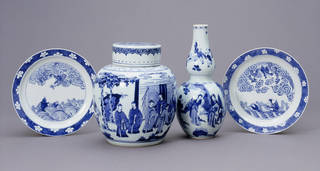Originally invented in China, blue-and-white ceramics were widely circulated, copied and re-created by makers worldwide, becoming one of the most well-known and enduring products in the history of Chinese porcelain.
Broadly speaking, blue-and-white refers to ceramics decorated with cobalt blue pigment on a white body, usually applied with a brush under the glaze. First appearing in the Tang dynasty (618 – 906), early blue-and-white ceramics were made with a coarse, greyish body. In the Yuan dynasty (1279 –1368), potters at Jingdezhen in Jiangxi province, a famous China porcelain town, refined clay recipes by adding kaolin clay, and developed firing technology. The craftsmanship of blue-and-white porcelain improved significantly, with products featuring vibrant blue colours using cobalt pigment produced in Yunnan province or imported from the Middle East.
Blue-and-white wares are produced elsewhere in China, though objects originating from the kilns at Jingdezhen are thought to be the best quality. Using the simple palette of blue and white, Jingdezhen potters incorporate a range of decorative techniques: combining dark and light blue to create striking contrast, or using areas reserved in white to create pattern on a densely painted blue background.
The blue pigment can also be used to draw detailed outlines, creating bold, sometimes cartoon-like images. This temple vase features a magnificent dragon with unusual bat-like wings and fins. The skilful, vivid lines reveal Jingdezhen potters' mastery of painting cobalt pigment with a brush on the uneven porcelain body.
Fenshui, a technique popular during the reign of the Kangxi Emperor (1662 – 1722), uses blue pigment painted in different shades to create an effect much like ink painting – seen here on a Kangxi vase, featuring birds, flowers and branches painted in different shades of blue. Blue-and-white porcelain produced during the Kangxi reign would later become some of the most highly prized by collectors in Europe.
Much blue-and-white porcelain made in the Yuan dynasty was intended for the Middle Eastern market. These were typically large vessels decorated with popular Chinese floral and animal motifs, such as the phoenix. Blue-and-white was also exported to Japan, Korea, South East Asia and as far as Africa.
Chinese blue-and-white inspired local porcelain production in distant markets. Many began by copying Chinese prototypes but used raw materials available nearby. The Arita kilns in Northwestern Kyushu island, Japan, are famous for their blue-and-white porcelain imitating Chinese styles. The repeated, linear pattern seen on this bowl produced in Arita comes from a simplified version of the Chinese character 'shou' (longevity), an extremely popular blue-and-white design from Fujian province, China.
Into the 16th century, large quantities of blue-and-white porcelain arrived in Europe, first through Portuguese merchants followed by the Dutch East India Company and other traders. The most iconic product of the early European trade is known as Kraak porcelain, a type of vessel featuring central decoration and alternating decorative borders.
As the trade expanded, many Chinese objects echoed European shapes or patterns. Examples in our collection include a vessel imitating a glass condiment bottle designed to separate oil and vinegar, and a large jar – part of a garniture – meant to be displayed on top of a piece of furniture or mantelpiece within a European residence. The decoration is a combination of traditional Chinese medallion, floral pattern and European figurines.
Into the 17th century, Chinese and Japanese ceramics were being made specifically for European export and traded in large quantities. Until ceramic manufacturers in England and Europe began to master and successfully market their own porcelain, Chinese products held a mysterious fascination, prized for its superior quality, and the fashion for Chinese porcelain thrived. By the late 18th and early 19th centuries, Chinese exports were in gradual decline however, until newly established treaties with China and Japan opened up more ports and reduced tariffs for foreign trade, rekindling an interest in East Asian art.
'Chinamania': the craze for blue-and-white in Britain
In the 1850s and 60s, antique blue-and-white ceramics were discovered by a small group of artists and intellectuals linked to the Aestheticism movement, who valued 'Art for Art's sake' (art that didn't tell stories or make moral points, but was enjoyed purely for visual pleasure). Engaged in the 'search for beauty', influential Aesthetic artists such as James McNeill Whistler and the Pre-Raphaelite painter Dante Gabriel Rossetti began eagerly collecting Chinese blue-and-white, sometimes known as 'Nankin' or 'Old blue', which was seen to embody true beauty in colour, material and form.

Blue-and-white fast became fashionable, not only amongst artists but also within a growing middle class who collected it in order to affirm their artistic, cultivated tastes. Part of its charm was the universally appealing colour combination, mirroring the natural blue and white of the sky and brightening up the typically dark Victorian interior. Antique blue-and-white, particularly from the Kangxi period (1662 – 1722), was also prized for the exquisite skill involved in its pre-industrial manufacture.
By the late 19th century blue-and-white had become an essential element of the 'house beautiful', with sideboards and cabinets being designed specifically for the elegant display of ceramics in the home. British shipping magnate Frederick Richards Leyland went so far as to commission a special room within his Kensington home, with wall supports made specifically to house his collection of blue-and-white porcelain. Designed by Thomas Jeckyll, the Peacock Room was famously redecorated at vast expense by Whistler with an elaborate colour scheme, which he believed would best show off Leyland's collection. The sum Whistler demanded for his interior decorations instigated a life-long feud between the two.

At the height of the blue-and-white craze, Aesthetes like Whistler himself were often ridiculed as suffering from 'Chinamania', valuing their blue-and-white porcelain above all else. By the time he died, Whistler's collection numbered over 300 objects, most of which are now in the Hunterian Museum, Glasgow, while some fine specimens owned by Whistler are on display in the V&A in our British Galleries (Room 123).


